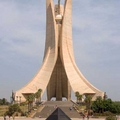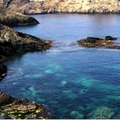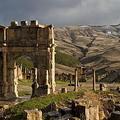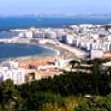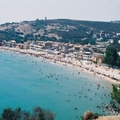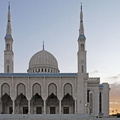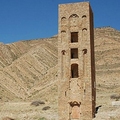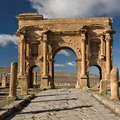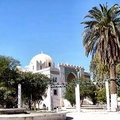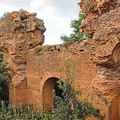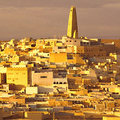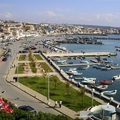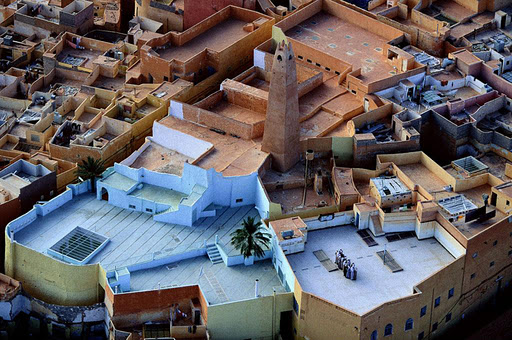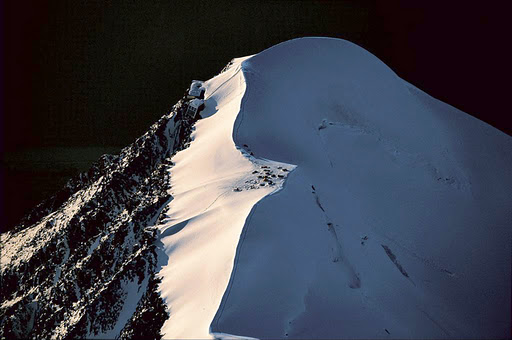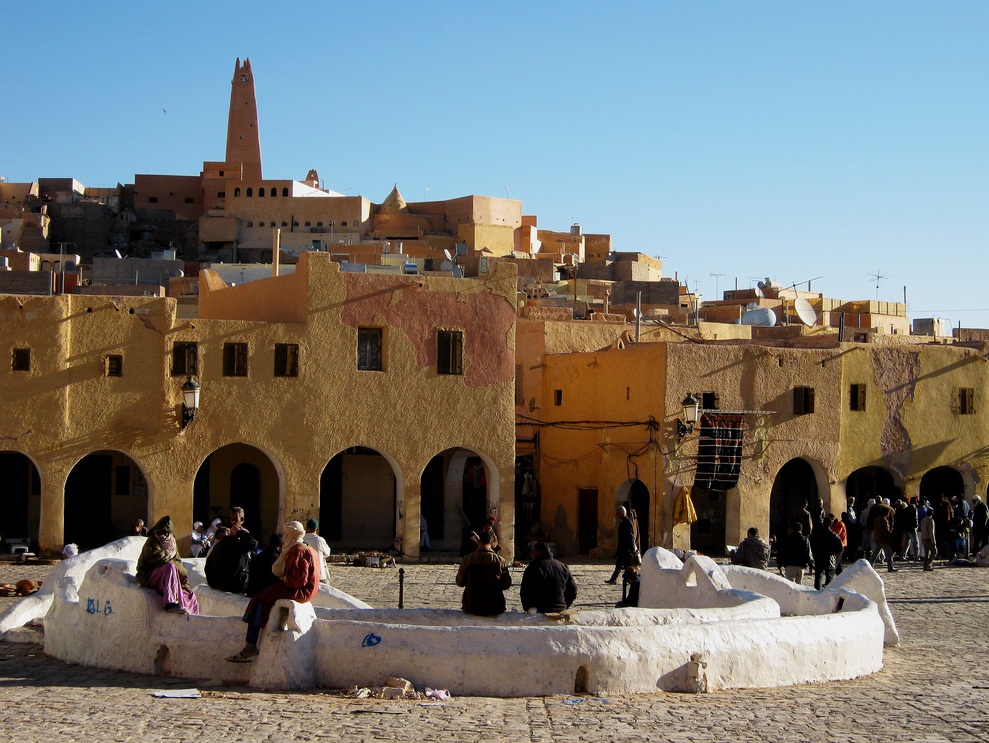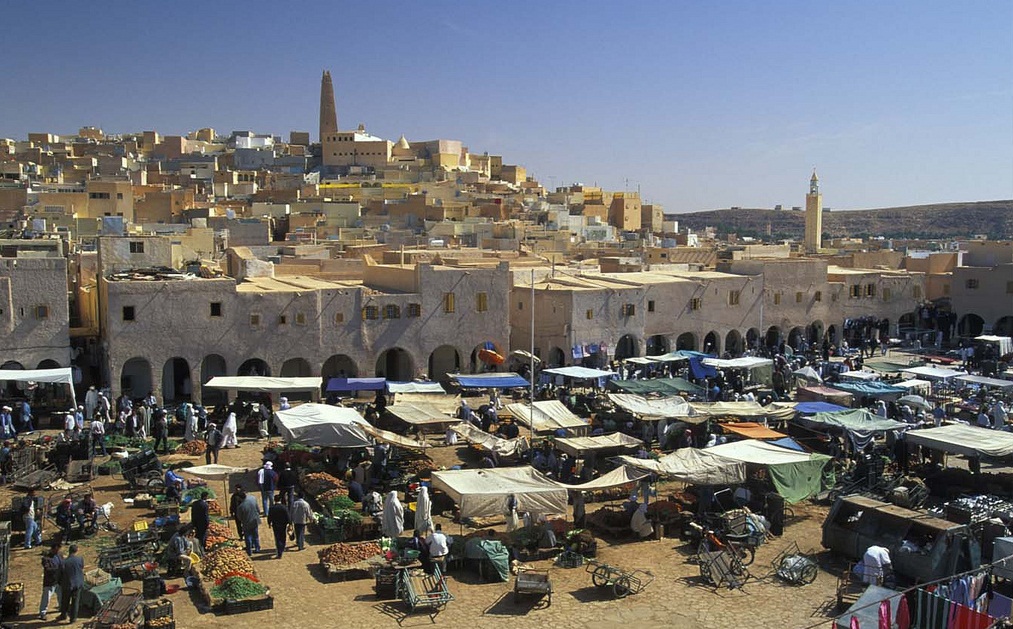World Tourism / The Best Places to Visit in Algeria / The Mzab Valley
The Mzab Valley
The Mzab Valley is an ancient habitat created around the X century by Berber Muslims. Simple, functional and perfectly adapted for the environment, the local architecture has been designed to live together, although it took into account the family structure. This architecture is the inspiration for the modern urban planners. Located 600 km south of Algeria, in the heart of the Sahara Desert, five ksour (fortified villages) in the Valley form an extremely homogeneous M'Zab formation of the ensemble, in the desert; the brand sedentary and urban civilization that has the original culture, which, through its own merit retained its unity over the centuries. Comprised of ksour and palm groves el-Atteuf, Bounoura, Melika, Ghardaia and Beni-Isguen (founded between 1012 and 1350), the Mzab Valley retained virtually the same lifestyle and the same construction techniques from the 11th century, ordered so many specific social and cultural contexts, as the need to adapt to the hostile environment, the choice of which responded to the historical need for the withdrawal of troops and the security imperative. Each of these miniature citadels is surrounded by walls and dominated by the mosque, a minaret, which functions as a fire tower. The mosque is designed as a fortress, the last bastion of resistance in case of siege, and includes an arsenal and a store grain. Around this building, which is important for communal life, the buildings are constructed in concentric circles to the ramparts. Each house is a cubic cell of standard type, illustrating an egalitarian society based on respect for the family structure in an effort to preserve its intimacy and autonomy. In the early first millennium Ibadis created in M'Zab with local materials, traditional architecture, which, with its excellent adaptation to the environment and the simplicity of its forms, is an example and an influence of modern architecture and urban planning. The human ensembles of the M'Zab Valley are witness to their extremely original architecture dating from the early 11th century, and their severity and the organization for outstanding and original model for studies of cultural communities of the central Sahara. This exemplary settlement had a significant influence over almost a millennium in the Arabic architecture and urban planning, including architects and urban planners of the 20th century, from Le Corbusier and Andre Fernand Puillonu Ravero.
Description
The three elements that make up the urban ensembles and the settlement of the M'Zab Valley : ksar, cemetary, and palm grove, with its summer citadel, are the exclusive proofs of the culture at its height Ibadis and egalitarian principle, which has been meticulously applied by the Mozabite society. The elements that make up the Valley of M'Zab, are an outstanding example of a traditional village, a representative culture of Ibadis, which, through the inventive system to capture the distribution of water and palm groves, show an extremely effective human interaction with the semi-arid environment. The M'Zab Valley, located within the Sahara, 600 miles south of Algeria, is a unique place in a limited area. Traces of very early settlement can be found on the plateau and rocky slopes, bounding the valley, which was ravaged by a rare and devastating flood Wadi. However, the systematic occupation of the land and the strikingly original adaptation of the architecture to the semi-desert site date from the beginning of the 11th century and were reached by a group of people, of some clearly defined religious, social and moral ideals. Ibadis, the doctrine is in many ways reached by the hard purists Khridjism, part of which was dominated by Maghreb during the 10th century. They founded the state capital, Tahert, destroyed by fire in 909, they then searched for other territorial base, first and last in Sedrata M'Zab. The place is a witness, in the most extraordinary manner, to the culture at its height Ibadi. The main reason for choosing this valley, which until then was inhabited by nomadic groups only sporadically, were defensive capabilities that offered a community that was concerned about his own defense and fiercely devoted to the preservation of its identity, even at the expense of isolation.
Unique area
The occupation of the land and the space organization were based on very strict principles, and their accuracy and detail have been exemplary in nature. A group of five ksours (ksar: fortified village) - El Atteuf, Bou Noura, Beni Isguen, Melika and Ghardia - located on the rocky outcrops and highly placed sedentary urban population. Each of these miniature citadels are surrounded by walls and dominated by the mosque, minaret, which functioned as a watchtower. Three constant elements – a ksar, a cemetery, a palm grove, with their summer stronghold are found in all five villages. They serve to illustrate the example of a traditional village, which is representative of the culture, which continued into the 20th century. The mosque, with its arsenal and stores of grain, was conceived as a fortress, the last bastion of resistance in case of siege. Every house, a cubic cell of standard type, illustrates the ideal egalitarian, while the grave in the cemetery only wise and small mosques differ in any way. The sample life in the Valley of M'Zab includes seasonal movement. Every summer the population is moving into the palm grove, where the 'Summer of' were marked by looser organizations, very protective nature of the buildings, the presence of fire towers, minarets and mosques without comparable with those in cemeteries. The settlement of the M'Zab Valley showed a significant influence on architects and urban planners of the 20th century by Le Corbusier to Pouillon.
Others The Best Places to Visit in Algeria .
Maps of The Mzab Valley
map AlgeriaOthers from The Best Places to Visit in Algeria
Algeria is a bizarre mix of different cultures and foreign influences.
Each city in this magical country keeps a lot of pleasant surprises for the curious researchers.
This is the second largest country in the entire African continent, therefore you can be sure that there are enough cities to visit.
It is worth noting that tourism in the region went into decline because of the outbreak of the political conflict in the country, accompanied by a reliable guide, armed with some sage advice, anyone can visit the most attractive areas of Algeria.
Ein Sefra is commonly referred to as `the gateway to the Sahara '.
The town itself is not rich in sights, but nevertheless this trend is noteworthy because it is one of the best places directly bordering the desert.
Algeria is the largest and the most important Algerian town, this area is definitely not to be missed.
This bustling metropolis, which will give you the opportunity to plunge into urban life.
You will find a delicate interweaving of architecture of ancient times to modern buildings, and when you get tired, let your eyes rest on the fresh glow of the Mediterranean.
Algeria is one of the best places to study the French-Arabic culture.
The next line is the amazing Annaba.
Fairly large city, which is largely similar to Algeria.
Annaba offers good food, convenient transportation and wonderful relaxing atmosphere.
Visit the city of Batna gives you the opportunity to see the ancient ruins of the ancient times.
There are many other wonderful places that are worth seeing in Algeria.
Most of the guests in the first few days may experience a slight culture shock of extraordinary experiences that makes this country.
It is worth noting that Algeria is not a lot of luxury service, which is so rich in America and Europe.
But people here are friendly and welcoming, they have an interesting culture, stunning architecture, amazing history and beautiful country - but what else is needed for a wonderful holiday! Currency The Algerian dinar Algerian dinar = 100 centimes, 1 U.
S.
dollar = 70 dinar, 1 euro = 98 dinars.
Geography Algeria is a country in North Africa, in the western Mediterranean basin.
Algeria borders Morocco to the west, Mauritania and Mali to the south-west, Nigeria to the south-east, Libya and Tunisia in the east.
Algeria is the second largest African country, a large portion of the area which lies in the Sahara desert.
Things to Do Excursions and sights of Algeria The ancient city of Algiers spreads like an amphitheater in the hills of the same name in the bay.
Most buildings are constructed of a light construction material which gives the city a festive look.
You can see the distinctive Arab Kasbah in the old town with quaint narrow streets and disorder one-story houses with flat roofs, graceful mosques and other buildings in the oriental style.
Among them are built in the XVII century mosques and tombs and the Siddhi Abdarrahman Jami al-Jadid Mosque.
Still, if anyone dares to visit Algeria, then do it mostly to see the Casbah - the old city, one of a kind left on the Earth.
Full of dark alleys and dead ends, the mysterious city is the heart of Algeria.
Alien and incurious, it shows only blank walls.
However, human and alive, these old neighborhoods remained unchanged since the XVI century.
This is the Medieval world, a world where every step faces night and day, shadows and lights.
Another jewel in the necklace of the Algerian wonders is Constantine, one of the most beautiful and unusual cities in the world.
Located on the north-east of the country, the city is relatively close to the border with Tunisia.
The city suddenly comes up and out of the pile of rocks, canyons and steep cliffs.
The once-rough river Rummel carved in the rock island.
On the island there was a city - Ksantis.
The river was gone, leaving it an empty eternal companion - left and right, top and bottom.
Our Swallow's Nest is vaguely reminiscent of that flying over the land the city.
One of the streets is called: 'Boulevard of the Abyss'.
Among other attractions is the healing power Meskutin Hammam.
It is said to cure all diseases (including diabetes, even).
The water is the hottest after the Icelandic geysers which is 98 degrees.
Tourists are advised to take raw eggs and eat, boiled in the source.
The country's history In ancient times, in what is now Algeria, ancient tribes lived.
On the coast was the Phoenician colony; III-II century BC.
State Numidia.
In the I century BC.
it was conquered by Rome, and in 47 BC.
it was converted into a Roman province; V century was the coastal part of North Africa (including the territory of modern Algeria) conquered the Vandals; VI century - Byzantines expelled the Vandals; VII century - the invasion of the Arabs.
The Arab Caliphate.
Islamization of the country; 1518 - fear of the colonial expansion of the Spaniards seized the coastal cities, the local rulers seek the help of the Turks.
Algeria in its present borders became a province of the Ottoman Empire.
On the coast of Algeria piracy flourishes; 1711 - achieved de facto independence from Turkey, 1830 - the beginning of French colonization.
The best lands of the country were inhabited by the colonists from Europe, 1848 - Algeria is declared a territory of France and it is headed by the French governor-general, July 1, 1962 - the vast majority of Algerians voted for independence, which was immediately recognized by the government of France.
More than a million Europeans and their supporters from among local residents hastily fled the country.
Climate Algeria has a subtropical Mediterranean climate in the north due to the tropical desert of the Sahara.
Winters on the coast are warm and rainy (12 ° C in January), in the mountains cool (2-3 weeks of snow), the Sahara is dependent on the time of day ( at night below 0 ° C, 20 ° C during the day).
Summer in Algiers are hot and dry.
The annual precipitation ranges from 0-50 mm in the Sahara to 400-1200 mm in the Atlas Mountains.
There are frequent dust storms and dry winds from the desert regions.
In this unusual country it is better to go in the autumn months, when the stifling heat begins to subside, and you can move around without risking to be burned alive.
In summer on the Atlantic coast can be very hot, and cold weather can ruin a trip.
Credit Cards Accepted in major cities.
Culture The state actively combats culture in the country.
Berber culture has an important place in contemporary Algeria.
But residents were replenished from the French, who were colonized for many years.
Museums Among the museums in the country the most interesting museum is that of ethnography and ancient history and the National Museum of Antiquities.
The National Museum of Fine Arts is worth visiting too.
All of them are in the capital, the museum in the city of Constantine Cirta is known for its archaeological exhibits.
You can also select the following: in Oran, the stronghold of Santa Cruz, the Great Mosque (XVII century), in Blida, a mosque built by the pirate Barbarossa (Hayraddinom) in Annaba, the ruins of the ancient city Afrodizium (early first millennium BC the city was a center of early Christianity and in 430 St.
Augustine died) In Constantine, the old city walls, built by the Arabs of the sculptures of the Roman period, the Roman citadel, the Sidiel-Cattani (XVIII century) Mosque, the palace of the XIX century, in Biskra – the Tomb conqueror of North Africa Okba (the earliest known inscription in Arabic script in Africa).
In the capital, the XVI century citadel, built by the Turks, and the old city.
Population :32,531,853 people, density - 13.
6 people / km ² .
Areas and Resorts in Algeria Algeria has four major physical regions.
In the north, stretching along the coast and leaving for the south 80 to 190 km, is located Tel consisting of narrow valleys ending part of the Atlas mountain range.
In the Atlas Mountains begins the main river in the country Chelif, which empties into the Mediterranean Sea.
In the south is the river Telya.
The second region is in the High Plateau, a few basins which in the rainy season forms small lakes.
After drying, they are transformed into the salt area, called Schott or chott.
The third region is the part of the Saharan Atlas Mountains.
The fourth, occupying more than 90% of the country is the Algerian Sahara desert stone.
In the south region are the Ahaggar Mountains and the highest point in Algeria the Tahat Mountain (3003 m).
Clothing You should not experiment clothes, else you may be a party scene, trembling with rage when the Algerians can `tear 'Europeans.
For them it is an insult and blasphemy.
Indeed, the Prophet Muhammad was a merchant, and this profession in the Muslim world is honorable and decent, and the money are respected.
Authorities Polity - the republic (in fact, the military regime).
The head of state is the president.
The head of Government is the Prime Minister.
The highest legislative body is the Parliament (unicameral National People's Congress).
Algeria is member of the IMF, the OAU, the Arab League, OPEC.
This president is Abdelaziz Bouteflika.
Food and water Lubia – the Algerian special dish, the flavor that comes from Dersu is a mixture of dried spices to the ground chilli pepper (to move to New Mexico, USA), garlic, caraway seeds and groundnut.
Dersu is the most commonly used in seasoning Algerian cuisine.
Traditionally, a little vinegar is added.
Also traditional is the chicken with green olives (mestalla).
Area 2,381,740 km ².
Shopping Purchases can be performed as in shopping centers and in local shops and at many markets.
Minerals There are significant deposits of iron, zinc, lead, copper, arsenic, mercury, and phosphates.
Rules of Conduct Bargaining is always appropriate and appreciated.
Holidays New Year's Day - January 1, Labor Day - May 1 Memorial Day - June 19 Independence Day - July 5 Anniversary of the Revolution - November 1, Ramadan, Eid al-Fitr, Eid al-Adha, New Year and Mawlid An-Nabi - religious holidays.
Nature and animals The flora of Algeria is quite poor.
Only a few tracts of forests in the north (oak, olive, pine and arborvitae) have survived.
In the Sahara desert, the vegetation, except for the small oases, is virtually absent.
The animal world is also not very diverse.
In recent decades, lions, leopards, gazelles, ostriches have almost entirely disappeared.
The berber macaque, the rabbit, jackals, hyenas, many lizards, 20 species of snakes, a large number of spiders, including phalanx and the scorpion are preserved.
Industry Algeria ranks the fifth in the world.
It’s largest natural gas reserves are oil.
Religion 99% Muslims.
Health Risks The main problem of the country's health - epidemics such as malaria and tuberculosis, malnutrition and trachoma.
Sanitary standards Sanitary-epidemiological situation leaves much to be desired, but there is no need for vaccinations.
Agriculture Cultivation of wheat, oats, and fruits, especially citrus fruits, and vegetables are developed.
Souvenirs A special attraction of Algeria is a large amount of carpet design and manufacturing processes that differ from region to region.
Jewelry and wood products are also included in the list of goods that should be seen.
Transport The length of the railway network of Algeria is of 3973 km, of which 283 km are electrified, road runs 85% of domestic passengers and 73% of all freight in Algeria.
The total length of 104 thousand km of roads, includes paved roads - 71.
7 thousand km.
The transport of passengers is represented by the railways and buses.
4 day trains run from Algiers to Oran, Algeria, one in El Shelif, one from Oran to Tlemcen, and two nights from Algiers to Annaba and Constantine.
Railroads in Laghouat and Biskra do not function.
In Tunisia and Morocco also.
The train costs more than the bus, but it is faster, for example, from Algeria in Oran - 4.
5 hours.
Buses are the main vehicle of Algerians, as the prices for tickets are not so high - one dinar per kilometer.
Night buses do not go in Annaba because of the danger of terrorism.
Roads are qualitative.
Tourism Tours in Algeria Algeria has a great potential for tourism development, in particular, it has thousands of kilometers of excellent beaches, under-utilized at present.
Festivals Exhibitions Ramadan is the ninth month of the lunar calendar, while events of the first revelation of the Prophet Mohammed.
This is also the month when God asks his faithful to fast from dawn until dusk, when they are healthy and do not travel.
After sunset, Muslims stop fasting, and generally begin with something sweet to raise blood sugar as Sunnah (one of the disciples of the Prophet Muhammad) ordered.
The evening is filled with all sorts of pleasures - eating, visiting with family friends, prayers in the mosque.
Flag The national flag of Algeria.
The aspect ratio of 2:3, consists of two vertical stripes of equal width of green and white.
A red star and a crescent are in the center.
The colors of the flag symbolize: Green - Islam, white - purity, red - freedom.
The crescent and the star are the symbols of Islam.
The crescent is more closed than in other Muslim countries, as the Algerians believe that the longer the horn crescent bring happiness.
Date of decision: 03.
07.
1962.
Tips are not accepted.
Language Arabic, French.

